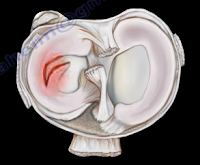 The acromioclavicular joint is located at the top of the shoulder, where
the acromion of the scapula and the clavicle join together. The AC joint is a
small synovial gliding joint that can be affected by arthritis and
osteoarthritis. The oblique orientation of the joint’s articular surfaces may
allow the acromion to be driven underneath the clavicle when the AC joint is
injured. The condition could be subtle. Injuries of the acromioclavicular joint
most commonly occur due to separation of the AC joint. Falling directly onto
the shoulder can injure the ligaments that stabilize the AC joint. The AC
ligament provides anterior-posterior stability of the AC joint. The posterior
and superior AC ligaments are most important for stability. The
coracoclavicular ligaments provide superior-inferior stability. Activity
related pain with overhead activity and arm adduction.
The acromioclavicular joint is located at the top of the shoulder, where
the acromion of the scapula and the clavicle join together. The AC joint is a
small synovial gliding joint that can be affected by arthritis and
osteoarthritis. The oblique orientation of the joint’s articular surfaces may
allow the acromion to be driven underneath the clavicle when the AC joint is
injured. The condition could be subtle. Injuries of the acromioclavicular joint
most commonly occur due to separation of the AC joint. Falling directly onto
the shoulder can injure the ligaments that stabilize the AC joint. The AC
ligament provides anterior-posterior stability of the AC joint. The posterior
and superior AC ligaments are most important for stability. The
coracoclavicular ligaments provide superior-inferior stability. Activity
related pain with overhead activity and arm adduction.
During the physical examination, in order to test for injury
to the AC joint, the physician will begin by palpating the AC joint. They
should check to see if pain is present with direct palpation of the AC joint.
If pressing down onto the AC joint causes pain, this is a sign of an AC joint
problem such as distal clavicle osteolysis, arthritis, sprain of the AC
ligament, or separation. Osteolysis of the distal clavicle is a localized area
of inflammation, hyperemia, microfracture, bone resorption, and eventually
arthritis of the AC joint. When pulling down on the shoulder, if there is a
separation of the AC joint, the clavicle will rise and a bump will be seen in
the area of the joint. Sometimes, this is demonstrated by adding weights and
comparing both sides. The cross body adduction test can also be done by
bringing the shoulder across the body. This squeezes the acromion and clavicle
together, causing pain directly in the area of the joint if an AC joint
separation or arthritis is present.

The acromioclavicular joint is best evaluated using the Zanca view radiograph. Using the Zanca view, the x-ray beam is directed with a cephalad angle of 15 degrees. Clavicular osteolysis can be assessed using the Zanca view. The acromion will be normal with the abnormality isolated to the distal clavicle. The Zanca view is also used for diagnosis of arthritis of the AC joint. It can show osteophytes and joint space narrowing. The patient’s symptoms may not correlate with the x-ray findings. An MRI will show an increased signal and edema in the AC joint.











